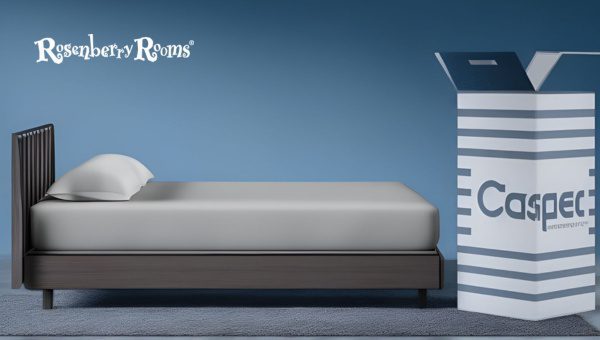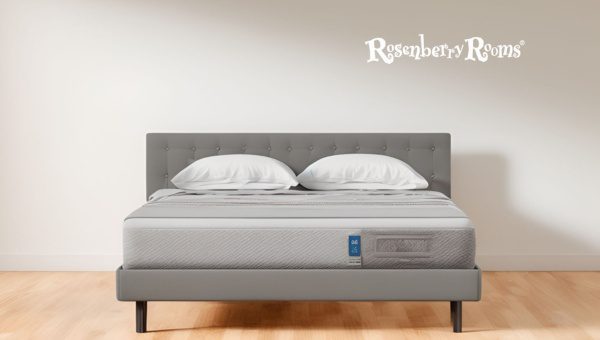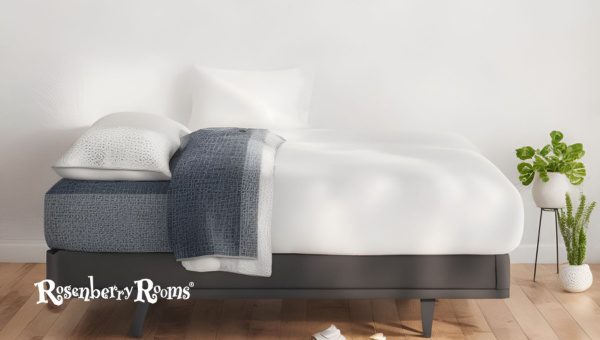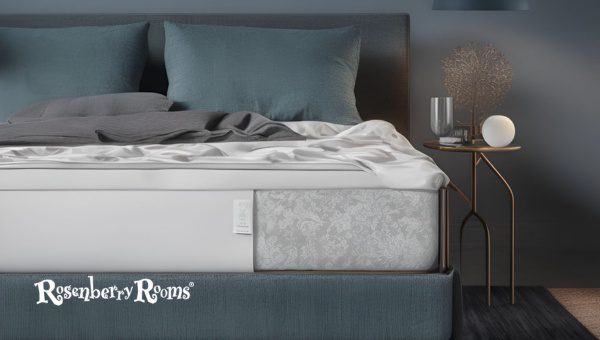Are you thinking about getting a good night's sleep on a well-reviewed and reliable mattress for your bedroom? Then, like many others, you might have considered the Casper mattress as an option.
The question that is likely lurking in your mind is, "does Casper mattress have fiberglass?" You are not alone in this. Many conscious buyers wonder the same thing as they prioritize their health and safety.
In order to help you with your quest for the best sleeping option, we're here to unravel this widely asked question and provide you with relevant information that will guide your buying decision.
It's a common misconception to associate all mattresses with fiberglass - but how true is it when it comes to Casper? Let's find out together.
Contents
Fiberglass is a type of fiber-reinforced plastic where glass fiber acts as the reinforced agent. The fibers may be randomly arranged, flattened into a sheet, or woven into a fabric.
The plastic matrix may be a thermosetting polymer or thermoplastic. It's lightweight yet stronger than many metals, making it highly durable and resistant to heat, corrosion, and weather conditions.
Fiberglass is widely used in various industries including automotive, construction for insulation, shipbuilding, aircraft, and even consumer products like bathtubs, surfboards and camping equipment due to its versatile properties.

Casper is a New York-based company that specializes in creating "sleep products" of the highest quality. The brand was launched in 2014 and has quickly made a name for itself as one of the leading online mattress companies, revolutionizing the market with its innovative bed-in-a-box formula.
The primary product of Casper is its line of memory foam and hybrid mattresses. Each model combines layers of supportive, breathable materials designed to improve sleep quality and increase comfort.
The all-foam Casper includes four distinct layers - a breathable comfort layer, memory foam layer, zoned transition foam layer, and durable support foam layer.
Besides mattresses, Casper also produces a variety of sleep-focused products like bedding, bed frames, pillows, duvets, night lamps and even dog beds.
Casper's mattresses are sold online through their website and are shipped directly to customers across North America and Europe. They also have physical stores where you can test their products before making a purchase.
Their dedication to manufacturing superior quality products coupled with the hassle-free online shopping experience and excellent customer service makes Casper one of the trusted brands in the mattress industry.
Fiberglass is often used in mattresses as a fire barrier due to its fire-resistant properties. It can withstand high temperatures and prevent the spread of fire, meeting federal safety requirements in several countries, including the United States.
It is lightweight and non-toxic, making it an effective and safe material for mattress usage. More importantly, fiberglass does not burn nor melt easily, adding to the layer of safety, especially when used in bedding products.
It's cost-effective. Compared to other fire-resistant materials like wool or aramid fibers, fiberglass is much cheaper while still fulfilling its role effectively. This can help keep overall costs down for mattress manufacturers and, ultimately, for consumers.
It's important to note that while it provides certain benefits, some people might have concerns over possible skin irritation due to broken glass fibers escaping from the mattress. Therefore, some manufacturers opt for alternative materials or methods to make their mattresses flame retardant without using fiberglass.
Explore More: How To Get A Free Mattress From Amazon? 2025 [Is It Possible?]

Yes, Casper mattresses do contain a layer of fiberglass, which is used as a flame retardant in compliance with federal safety standards.
The fiberglass is not exposed to the user as it is placed within the inner layers of the mattress and does not come into direct contact with the sleeper.
To ensure safety and prevent potential skin irritation, Casper advises not to remove the mattress cover or machine wash it.

Comprehending the various types of fiberglass is crucial in understanding its application, particularly in industries like mattresses.
Fiberglass is categorized into distinct types, each carrying a unique set of properties that make them suitable for individual purposes and applications. Let's break down the main types: S-Glass, E-Glass, AR-Glass, A-Glass, and C-Glass.
S-Glass, also known as structural glass, is known for its high mechanical performance. It has nearly 40% higher strength compared to E-Glass, another type of fiberglass.
S-Glass is made from pure silica sand and magnesia which contribute to its superior properties like increased heat resistance and improved tensile strength.
It is mainly used in applications where high mechanical strength and high temperature resistance are required. This includes spacecraft, defense vehicles, sporting goods like hockey sticks or surfboards, helmets, and even some specialty mattresses that seek higher durability and impact-resistance.
While it's stronger than E-Glass, S-Glass often comes with a higher price tag due to its enhanced characteristics.
The another name of E-Glass is electrical glass, is the most commonly used form of fiberglass in various industries. Named for its originally intended use as an electric insulator, this type of fiberglass is highly beneficial due to its excellent insulative properties, high strength, and lower cost compared to other forms of fiberglass.
E-Glass is composed mainly of alumina, silica, lime and boron oxide. This composition results in a material that’s highly resistant to electric currents and also thermally efficient.
E-Glass showcases a good balance between cost-effectiveness and performance - it's stronger than A or C-Glass but cheaper than S-Glass.
Its strength, durability and affordability make it suitable for many applications such as printed circuit boards, storage tanks, boat hulls, automobile bodies and often in the inner layers of mattresses for fire safety.
AR-Glass, or Alkali-Resistant Glass, is a type of fiberglass specifically formulated to resist degradation caused by alkaline conditions. It is made up of a mixture of silica, lime, and small amounts of alumina and boron.
The key feature that sets AR-Glass apart is its ability to withstand high pH environments which are typically detrimental to other forms of fiberglass. This alkaline resistance makes it especially suitable for use in concrete products.
When added to concrete, AR-Glass fibers provide three-dimensional reinforcement that enhances flexibility and durability, making it impact-resistant and helping to prevent cracking.
Such characteristics make AR-glass an excellent choice for construction purposes like building facades, decorative panels, or industrial flooring systems where enduring structural integrity is critical.
A-Glass, also known as soda-lime glass, is among the most common types of fiberglass. It's called A-Glass due to its 'Alkali' content - composed predominantly of silica, lime, and soda (sodium carbonate), also similar to the components of window glass.
While it offers a fair level of physical strength and chemical resistance, it does not perform as well in comparison to E-Glass or S-glass when faced with extreme conditions. It provides a satisfactory level of electrical insulation and has good forming capabilities.
A-Glass is often utilized where high performance isn't necessarily required but cost-effectiveness is critical.
For regular household items like drinkware or flat glass products that do not have heavy-duty requirements, A-Glass serves quite efficiently.
Due to its lower performance in resisting harsh environments and temperatures in contrast to other types of fiberglass, it's typically not used for mattress construction or other high-resilience applications.
C-Glass (chemical glass) is a type of fiberglass known for its exceptional chemical resistance, particularly in acidic environments. It is made from high purity silica sand and limestone, with a small amount of boron.
Specially designed to resist chemical attack and corrosion, C-Glass fibers are often used in applications where exposure to harsh chemicals or corrosive environments can be expected.
They have found extensive usage in the manufacturing of corrosion-resistant composites and materials that go into making protective clothing or equipment.
It's high resistance to water attack also makes it ideal as a reinforcement material in plastics for pipe, tank and other equipment used in water treatment plants.
Compared to other types like E-Glass or S-Glass, C-Glass possesses relatively lower strength and stiffness properties — characteristics that make it less suitable for applications such as mattress fire barriers where strength could be more critical.
Once you start digging deeper, you'll realize not all mattresses are created the same. Yes, that's true! There are indeed more holistic, skin-friendly, and fiberglass-free options available in the market for you.
Why compromise comfort or health when there are trustworthy alternatives at your fingertips? Let's delve into some notable names providing such solutions.
Also Read: 15 Best Mattress Without Fiberglass To Buy In 2025
Saatva is a notable mattress brand offering a range of fiberglass-free options. Known for their premium quality and commitment to sustainability, Saatvaa's mattresses are designed with no harmful chemicals or materials that could potentially irritate the skin or cause other health issues.
One of the standout characteristics of Saatva’s mattresses is their approach to using non-toxic chemicals. Unlike some companies that use harsh chemicals in the production process, Saatva employs eco-friendly processes that are beneficial both for users and for the environment.
A key component in Saatva's mattresses is the flame-retardant barrier made from a synthetic material called thistle pulp or wood pulp. The use of this material ensures you don’t have to worry about skin irritation or inhalation problems often associated with fiberglass.
To enhance its fire safety measures without resorting to potentially harmful substances, Saatva also uses organic wool as part of its flame retardant layer. Organic wool naturally resists fire, adds plushness, and effectively wicks away moisture – adding another degree of comfort to your sleep experience.
If you're looking for a mattress option that avoids fiberglass completely while also focusing on sustainability and user comfort, then Saatva may well be the brand worth consideration.
Puffy is another brand that offers excellent fiberglass-free mattress alternatives. Puffy mattresses are renowned for their high-quality construction, durability, and luxurious comfort.
Instead of relying on potential irritants like fiberglass for fire safety and structural integrity, Puffy adopts a different approach, using an organic materials blend with coils to form its mattresses.
The core of Puffy’s mattresses integrates individually-wrapped coils that provide ample support while reducing motion transfer effect, i.e., disturbances from a partner's movements during sleep. This supportive coil system enhances airflow within the mattress, helping you sleep cool throughout the night.
Encasing these coils is a layer of Cooling Cloud foam mixed with gel that aids in heat dissipation and provides optimal temperature control.
All the materials used in Puffy mattresses are CertiPUR-US Certified, assuring they're made without ozone depleters, heavy metals, or formaldehyde — thus ensuring you’re sleeping on a safe, healthy surface.
So if organic materials, along with responsiveness and cooling features, rank high on your priorities list when selecting a mattress, then a Puffy mattress could serve as an excellent fiberglass-free alternative.
Amerisleep is also a leading brand that provides fiberglass-free mattresses. The brand prides itself on using 100% organic components in making its assortment of mattresses which are certified to be comfortable, durable, and environmentally friendly.
Amerisleep mattresses use Bio-Pur foam, which is a blend of organic components such as aloe vera, tea extracts, and castor oil. This brings a fresh scent to the mattress while also offering potential benefits like aiding restful sleep and alleviating stress.
To ensure safety against fires without using fiberglass or harmful chemicals, Amerisleep employs a natural flame retardant made from plant fibers. They utilize a cover made from Thermocool fabric – woven with specially designed thermo-conductive fibers.
Besides being organic and safe, Amerisleep also places significant emphasis on ergonomics. The thoughtfully designed layers in their mattresses denote areas of different firmness levels – ensuring you get the right amount of support where your body needs it most.
Whether you're a side sleeper requiring extra cushion for your shoulders and hips or have back pain concerns needing robust lumbar support – there's a mattress tailored specifically for your needs.
If you're on the lookout for an all-organic alternative to traditional mattresses while also focusing on enhanced ergonomics and support options, then Amerisleep holds plenty of merits worth considering.
Understanding both the upsides and downsides of fiberglass in mattresses can be vital when it comes to investing in your restful supernights.
You probably want a mattress that perfectly blends comfort, support, and durability- yet keeps your health and safety top priority.
That's why we have thoroughly researched the topic to present you with a comprehensive list of pros and cons should you come across a mattress containing fiberglass.

It ultimately depends on individual preferences and needs. If the comfort, support, and conforming features of a Casper mattress meet your requirements, then yes, it might be worth it – provided you follow the manufacturer's care instructions and don't remove or wash the outer cover to prevent exposure to fiberglass.
If the presence of fiberglass is a deal-breaker for you due to potential health concerns or skin sensitivity issues, then you should have to see another one.
There are several high-quality fiberglass-free mattresses on the market, such as Saatva, Puffy and Amerisleep that offer excellent comfort without using any quantity of fiberglass in their products.
Ensuring comfortable sleep along with sound health should always be your top priority while picking a mattress.
Also Read: When Is The Best Time To Buy A Mattress In 2025? [Best Months]
Yes, indeed, Casper mattresses are created without the use of any fiberglass.
No, you won't find any fiberglass content in the mattress covers of Casper products.
Casper mattresses predominantly contain memory foam, polyurethane foam, and polyester in their construction.
Since Casper doesn't use fiberglass in their mattresses, there would be no direct health risks related to this material.
Yes, regardless of the model or size you select, none of the Casper mattresses incorporates any trace of fiberglass.
If you're seeking a mattress free from fiberglass, Casper should undoubtedly be on your radar. Adhering to strict standards for safety and comfort, Casper ensures that their mattresses go beyond simply giving you a luxurious sleeping experience.
They prioritize your health too. Remember, making the right choice for your sweet dreams is about considering all the vital aspects - from comfort and durability to safety and care.